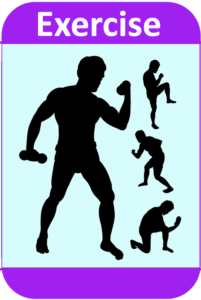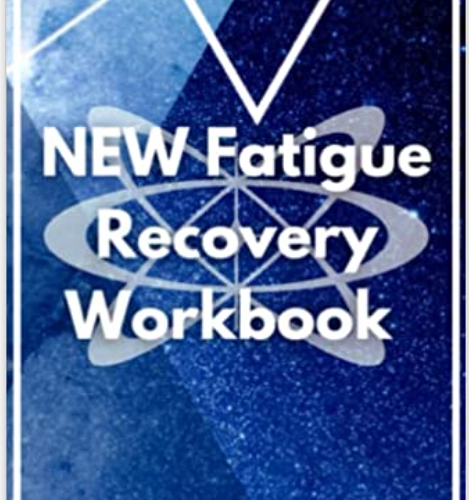As we have discovered, Fatigue can be debilitating and can affect every aspect of a person’s life. It can lead to decreased productivity, lower quality of life, and mental and emotional strain. In this message, we will discuss our signature book, the NEW Fatigue Recovery Workbook, and how it can help individuals overcome fatigue-related symptoms through a focus on Nutrition, Exercise, and Wisdom. Of course, this will be a summary of these 3 pillars of health. Our blog site, SAReid.com has more information on each area of interest.
Nutrition: A Balance Diet Can Reduce Fatigue
Nutrition is an essential component of the NEW approach to fatigue recovery. According to a study by the Centers for Disease Control and Prevention (CDC), a balanced diet can reduce fatigue symptoms and promote energy levels. The workbook emphasizes the importance of meal planning, hydration, and medication management, as applicable.

- Meal Planning
The workbook was designed for you to record meal times and to include shortcodes for meal descriptions. This is vital to understand users’ energy levels throughout the day, by reviewing the frequency of meals, and the type of food eaten. For some, it may be 3 to 5 meals per day, and these meals may be hard food or pureed for ease of consumption. Note however, it will be the user’s and caregiver’s responsibility to determine proper meal planning and preparation, including tips on food choices and portion control.
By tracking what is eaten and how much, patients can understand how these factors impact fatigue levels. Remember, optimum body weight supports better health, so look for ways to achieve your ideal body weight range. The workbook allows for a variety of recipes that are rich in energy-boosting nutrients like iron, protein, and complex carbohydrates.
Iron is crucial for carrying oxygen to the body’s tissues and can be found in foods like lean meats, beans, and dark leafy greens. Protein is essential for building and repairing tissues and can be found in foods like lean meats, eggs, and beans. Complex carbohydrates provide a sustained source of energy and can be found in foods like whole grains, fruits, and vegetables. Choose healthy foods, which the user can tolerate and monitor those with unwanted side effects.
- Hydration
The workbook also highlights the importance of staying hydrated to combat fatigue. It shows images of 10 cups to remind users how many cups of 8 ounces of water are consumed daily. Dehydration can cause fatigue, dizziness, and headaches, among other symptoms. Users and caregivers can also be creative by including teas, and soups with meals to increase hydration. Users are encouraged to gradually sip water between meals, track their water consumption, and aim for at least eight glasses of water per day.
- Medication Management
If applicable, the workbook allows users to state whether or not they are on any medication. Be aware that some medications and/or supplements may cause fatigue as a side effect. Users are encouraged to track their medication and supplement usage and discuss concerns with their healthcare provider.
Exercise: Apply Graded Exercise Therapy
Exercise is another critical component of the NEW approach to fatigue recovery, which can reduce fatigue symptoms and promote energy levels. Getting sunlight, walking, stretching, and sleep are included in this section for regular exercise. Exercise should not only be seen as an external output but also as an internal multi-functional biological system. That is, even when we are sleeping, our bodies are hard at work with the respiratory and blood circulatory systems. It will be the user’s and caregiver’s responsibility to document the duration, steps, and/or repetitions of the graded exercise therapy routine.

- Low-impact Exercises
For those who may be experiencing fatigue, low-impact exercises are recommended. These exercises are less strenuous on the body and include activities like walking, stretching, and yoga. The workbook also allows users to exercise while laying, sitting, and/or standing. Sticking to an exercise or workout schedule will help blood circulation, and improve appetite and overall body health when done properly.
- High-Intensity Exercises
For those who are able to handle more intense workouts, the workbook allows users to state their high-intensity exercises. These exercises include activities like running, weightlifting, and cardio workouts as users progress at their respective levels. It is the user’s and caregiver’s responsibility to determine a variety of workout plans for targeted muscle areas of the body to gain intermediate fitness levels and goals.
- Sleep
The workbook also emphasizes the importance of getting enough sleep for restoring the body, mind, and soul. Sleep is critical for promoting overall health and well-being; lack of sleep can contribute to fatigue. Sunlight can help coordinate wake time. Be aware that technology screen time and conversations must be managed during downtime. Users are encouraged to track their sleep patterns and make adjustments to maximize their sleep habits if necessary.
Wisdom: Be Mindful and Sensitive to Your Body
The third key element of the NEW approach to fatigue recovery is wisdom, which encompasses mindfulness, meditation, inspiration, and positive conversations. While there are many options available in our information age, we need to apply wisdom to know what is necessary for users’ well-being. It is the users’ and caregivers’ responsibility to manage negative thoughts and moods and resources for finding inspiration and support online.

- Mindfulness
The workbook allows mindfulness practices, which can help reduce stress, promote a sense of calm and realize mind-over-body presence. Mindfulness exercises can include activities like deep breathing, stillness, clearing the conscience, visualization, memorization, and meditation. Knowing scriptures, words of affirmation, lyrics of praise-worthy songs, prayerful declarations, and other ways to enhance fearless factors can all help mindfulness.
- Positive Conversations
Some users may find it difficult to engage in conversations as before. Debates, arguments, and contradictions can all exhaust the easily fatigued person. Conversations with friends, family, and healthcare providers can be a valuable source of support and motivation. The way we talk to ourselves and others can significantly impact our mood and well-being. Engaging in positive conversations and focusing on solutions rather than problems can be a powerful tool for managing fatigue-related symptoms. Monitoring heavy breathing, and unusual chest movements can be leading indicators of an episode for a fatigued person. The NEW Fatigue Recovery Workbook allows strategies for effective communication, such as active listening, assertive communication, and conflict resolution.
3. Cultivate Resilience:
Finally, cultivating resilience is another critical component of the NEW approach to fatigue recovery. Resilience refers to the ability to bounce back from adversity and overcome challenges. By developing resilience, users can build their capacity to manage stress, stay motivated, and maintain a positive outlook. The aim of the NEW Fatigue Recovery Workbook is to build resilience, such as setting achievable goals, practicing self-care, and seeking support from family and friends through nutrition, exercise, and wisdom.
Conclusion: Pace Yourself with the NEW Fatigue Recovery
Fatigue-related symptoms can be challenging to manage, but with the right approach, users can regain control of their lives and find renewed energy and vitality. The NEW Fatigue Recovery Workbook offers a comprehensive guide to managing fatigue through a focus on nutrition, exercise, and wisdom. By tracking nutrition, incorporating physical activity, and cultivating mindfulness and self-care, users can achieve optimal health and well-being.
The categories and format in the workbook are designed to effectively manage fatigue-related symptoms. However, it is important to note that fatigue can be a complex condition, and individual results may vary. It is always best to consult with a healthcare professional before making significant changes to your diet or exercise routine.
In conclusion, the NEW Fatigue Recovery Workbook provides a practical and comprehensive guide to managing fatigue-related symptoms. By following the NEW approach, users can take control of their health and well-being and find renewed energy and vitality in their daily lives. Get your copy of the NEW Fatigue Recovery Workbook today.
References:
Graded Exercise Therapy (I): Understanding Its Benefits and Risks

seggars xyandanxvurulmus.m59g66d00HGV
escort pompadirha.Uhc163ehj7lo
fuck google asillartaklitler.k0yjDiKmzJcp
anal sikis siteleri hephupx.IUwBuaaG0ynQ
porno izle hepxhupx.1en5DK7A7qAR
porn juljulfbi.DZ0wskDsqnqz
Servislerimiz sayesinde sms onay sizde en uygun fiyatlardan mobil hesap sms telefon onay yaptırabilirsiniz.
bahis siteleri sikis 250tldenemebonusuxx.CtKHJvqMlV6w
anal siteleri eyeconartxx.ifuW40Z07LLj
seks siteleri vvsetohimalxxvc.fz0vATJkLHkt
BİZİ SİK BİZ BUNU HAK EDİYORUZ tthighereduhryyy.U3K9r5O3nSi
Wow, marvelous blog format! How long have you been running
a blog for? you made running a blog glance easy.
The total look of your web site is fantastic, let alone the content!
You can see similar: sklep online and here sklep internetowy
Very nice post. I simply stumbled upon your weblog and wanted to mention that
I have truly enjoyed browsing your blog posts.
After all I’ll be subscribing on your rss feed and I
am hoping you write again very soon! I saw similar here: sklep online and also
here: najlepszy sklep
teen porno hd gghkyogg.kdzkElf6zQ9
hot porn 4k ggjennifegg.aTBXzbt6WeY
hd full sex ggjinnysflogg.kRokXV7ehly
You are so awesome! I do not think I’ve read through a single thing like this before.
So nice to discover somebody with some unique thoughts on this topic.
Really.. thank you for starting this up. This web site is
one thing that’s needed on the internet, someone with a bit of originality!
I saw similar here: Ecommerce
I’m gone to convey my little brother, that he should also go to see this
blog on regular basis to obtain updated from hottest news update.
I saw similar here: Dobry sklep
It’s very interesting! If you need help, look here: ARA Agency
It’s very interesting! If you need help, look here: ARA Agency
fashionflag porn daunlod fashionflag.66lTaVeDjaz
goodhere Swingers porn vurucutewet.Qvz6wWIj4GP
ladyandtherose Funny Sex porn backlinkseox.ArKpFOU5f5o
jenniferroy ウェブカメラ japanesexxporns.YTW3ZdsmAEO
landuse Hardcore porn lancdcuse.s9SpcsmwUGD
falbobrospizzamadison Ebony porn jkkıjxxx.1k7fZvBoIrK
बड़ा गधा अश्लील hkyonet.NbR5VAdoa1p
Your comment is awaiting moderation.
Oh my goodness! Incredible article dude! Thanks, However I am encountering issues with your RSS. I don’t know the reason why I can’t join it. Is there anybody getting the same RSS issues? Anyone who knows the solution can you kindly respond? Thanx.